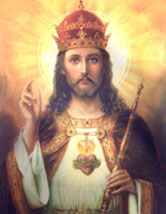 |
|
| ||||||||
|
What is Catholic Education?
|
.jpg) |
Pope Pius XI's encyclical on the Christian Education of Youth is the blueprint for Catholic education. |
These poor misguided youths have been cheated of the salvation offered to them by God through the Catholic Church. They are the products of a Catholic school system criminally indifferent about their eternal happiness, as another survey indicates. The 1990 Blishen Report on Catholic Education in Ontario found that on a scale of 1 to 7, parents, teachers, and school trustees rated helping students to learn to pray at 3.5 (clergy gave it 4.4). Encouraging participation in church received a 3.8 from the first three groups, whilst clergy gave it a 4.8! That means no one involved in today’s Catholic education (the survey’s results can be extrapolated worldwide, as the demise in Catholic education is universal), including the clergy, knows what it means to be a practising Catholic. The report found 64% of Grade 12 students, 51% of parents, 29% of teachers and 13% of school trustees did not attend Sunday Mass.[11]
A Grade 12 student recently complained in Toronto’s archdiocesan newspaper [12], “Catholic students who actively practise their faith are becoming a minority within Catholic schools.” Students think there is something wrong with you if you go to the chapel to pray, he said. Religion is “regarded as a course teaching outdated and useless morality.” However, some teachers blame parents for this state of affairs. Students “lack the fundamental foundation that should be established at home” [13] — this despite the fact that for decades schools have reacted hostilely towards parents who have criticized them for undermining the religious values taught at home!
Further, many parents — as well as teachers and clergy — educated in the last 35 years are themselves victims of deteriorating Catholic schools in which Catholicism has been gradually replaced with humanistic New Age or global education.[14] Teachers’ associations and Ministries and Departments of Education have all been promulgating this anti-Christian education. The American National Catholic Education Association (NCEA) has, since 1972, worked to implement a New Age curriculum in the schools, and its conferences have featured New Agers, including occultists.[15] A forthcoming article by this writer will fully describe global education.
The growing number of home and parent-run schools indicates that at least some parents are very unhappy about the Catholicity of Catholic schools. Where home and parent-run schools are not options, they are using secular or fundamentalist Protestant schools, believing their children’s faith is not being attacked in them and it can then be taught at home.
But, in general, most Catholic parents do not know just what is meant by Catholic education. That’s because most do not know that there is a blueprint for Catholic education: Pope Pius XI’s encyclical on the Christian Education of Youth, Divini Illius Magistri.[16] It was faithfully followed by the great religious teaching orders that ran the Catholic educational system. After Vatican II, when the orders abandoned teaching, relegating education to laymen, they played right into the hands of the Freemasons, who had long sought to control Catholic education.[17] The Catholic blueprint was discarded [18] and replaced by another blueprint. Today the schools still have Catholic names, but they are New Age schools. Catholic graduates hardly differ from their secular counterparts, because they are all moulded from the same New Age blueprint.
The purpose of this article is to describe the Catholic blueprint; on comparing it with today’s education, one is astounded to see how far off track Catholics have strayed, and how wrong our thinking is today.
Principles of Catholic Education
Divini Illius is a crystal-clear presentation of the fundamental principles upon which sound Catholic education rests. The blueprint can be broken down into eleven characteristics or principles of Catholic education, [19] which are the criteria by which one can judge whether a particular school system is Catholic or not.
Let us now consider these eleven principles or criteria.
1. The goal or purpose of education.
According to Pius XI, all education “consists essentially in preparing man for what he must be and for what he must do here below, in order to attain the sublime end for which he was created.” That, then, is the purpose of education: to instruct man how to live so that he may achieve eternal happiness. This goal makes perfect sense, as after all, the whole purpose of our existence is to know, love, and serve God in this world, so that we can be happy with Him in the next.
| "The purpose of education is to instruct man how to live so that he may achieve eternal happiness." |
Hence, the Pope continues, “it is clear that there can be no true education which is not wholly directed to man’s last end” [20] and since God the Son “alone is ‘the way, the truth and the life,’ there can be no ideally perfect education which is not Christian education.” In fact, Christian education is of “supreme importance,” “not merely for each individual, but for families and for the whole of human society, whose perfection comes from the perfection of the elements that compose it.” It is of “unsurpassed excellence” because it “aims at securing the Supreme Good, that is, God, for the souls of those who are being educated, and the maximum of well-being possible here below for human society. And this it does as efficaciously as man is capable of doing it, namely by cooperating with God in the perfecting of individuals and society.” This is because “the proper and immediate end of Christian education is to cooperate with divine grace to form Christ in every student.”
Contrast this with modern education. At best, its goal, on the surface, is to teach skills to prepare children for the job market and/or secondary education. Even Catholics believe this is the chief purpose of education.[21] The concept that it is meant to ensure our eternal happiness would be alien to most Catholics today. This is not surprising, as Vatican II’s Declaration on Christian Education, Gravissimum Educationis, although making a few passing references to man’s final end, actually shifted the purpose of education from the “vertical” to the “horizontal” plane.
Its focus became humanistic and naturalistic and aligned with the United Nations’ goal of education — as a human right — for all men, “in order to promote true unity and peace in the world.” Students were to be trained in the skills needed for jobs and to “participate actively” in society. Education, says Gravissimum, is “for the development of a world more worthy of man.”[22] This focus — still unknown to most parents forty years later — opened the door to the indoctrination of children with politicized New Age education.
2. The product of Christian education.
True Christian education is meant to produce the Christian, the person of “character,” who thinks and acts “in accordance with right reason illumined by the supernatural light of the example and teaching of Christ,” and whose conduct is based on “eternal principles of justice” and not on “subjective principles,” says Pius XI. Full justice, he adds, means giving God His due — i.e., the true Catholic displays in all his actions that he lives a supernatural life in Christ.[23]
| The product of Christian education is the Christian who acts "in accordance with right reason illumined by the supernatural light of Christ." |
As mentioned, Catholic schools are not producing Christians who know right from wrong (the “eternal principles,” without which justice is impossible). This is because they are subjected to humanistic values-clarification education, which teaches that right and wrong is a matter of personal preference (“subjective principles of justice”). Some Catholic educators recognize that today’s students are running amok, but their solution is to instill a new “improved” values education which uses classical fiction stories that have some generally accepted moral attached to them. In theory, this is a bandaid solution; in practice, it actually increases moral and religious relativism because under the umbrella of “classical” it includes the beliefs of pagan religions, equating them with Christian values.[24]
Pius XI saw this trend towards pedagogic naturalism as far back as 1929 and condemned it:
... what is intended by not a few, is the withdrawal of education from every sort of dependence on the divine law. So today we see ... educators and philosophers who spend their lives in searching for a universal moral code of education, as if there existed no decalogue, no gospel law, no law even of nature stamped by God on the heart of man, promulgated by right reason, and codified in positive revelation by God Himself in the ten commandments. These innovators are wont to refer contemptuously to Christian education as "heteronomous," "passive," "obsolete," because founded upon the authority of God and His holy law.
Such men are miserably deluded in their claim to emancipate, as they say, the child, while in reality they are making him the slave of his own blind pride and of his disorderly affections, which, as a logical consequence of this false system, come to be justified as legitimate demands of a so-called autonomous nature.[25]
In other words, without turning to Christ and the “eternal principles of justice” — the Ten Commandments — one can never produce a person who knows right from wrong. Therefore, without true Catholic education, the world will revert to barbarism — as it is doing right now.
3. Role of the Church
“Education belongs pre-eminently to the Church,” states Pius XI, because of her double title of Teacher and Mother, given to her by God Himself. She is Teacher because of her Divine Founder’s command to teach all nations His doctrine.[26] “Hence,” says the Pope, quoting Blessed Pius IX, “the Church ‘was set by her Divine Author as the pillar and ground of truth, ... to direct and fashion men, in all their actions, individually and socially, to purity of morals and integrity of life, in accordance with revealed doctrine’.”
Since God has granted the Church immunity from error in faith and morals, she “is independent of any sort of earthly power ... in [the] exercise of her mission as educator, not merely in regard to her proper end..., but also in regard to the means necessary ... to attain that end.” Therefore, with regard to every kind of learning (including science [27] and physical education), the Church, as a wise mother, “has the right to decide what may help or what may harm Christian education.”
| "'Education belongs pre-eminently to the Church,' said Pius XI. True education, therefore, is only possible under the Church's guidance." |
“And this must be so,” adds Pius XI, “because every form of instruction, no less than every human action, has a necessary connection with man’s last end, and therefore cannot be withdrawn from the dictates of the divine law, of which the Church is guardian, interpreter and infallible mistress.” He cites St. Pius X for this truth: The Christian “must ... direct all things toward the supreme good as to his last end; all his actions, besides, in so far as good or evil in the order of morality, that is, in keeping or not with natural and divine law, fall under the judgment and jurisdiction of the Church.”
In practice, this means everything in the Catholic school must be conducive to man’s last end and in harmony with the teachings of the Church. This watchfulness of the Church aids “the right ordering and well-being of families and of civil society; for it keeps far away from youth the moral poison which at that inexperienced ... age more easily penetrates the mind and more rapidly spreads its baneful effects.” Pope Pius quotes Leo XIII’s observation that without proper religious and moral instruction, “every form of intellectual culture will be injurious.”
Since the Church’s educational role embraces every nation, “there is no power on earth that may lawfully oppose her,” says Pius XI. He reminds us of the Church’s rich history of excellence in education; indeed, that civilization and progress resulted from Christianity because of her “immense number of schools and institutions in every branch of learning,” which have educated millions through the centuries and throughout the world.
Giving the lie to the Age of Apologies, the pontiff says history proves that the Church’s many social, charitable and educational institutions, and “a vast number of saintly educators,” “have benefitted society” and nations all over the world. These valuable fruits of Christian education are “derived from the supernatural virtue and life in Christ which [it] ... develops in man.” This justifies the Church’s view that the only perfect education is Christian education and the “good Catholic makes the better citizen”; so that “no one free from prejudice can have a reasonable motive for opposing” the Church in this work, “of which the world today enjoys the precious advantages.”
True education is, therefore, only possible under the Church’s guidance — but obviously not under rebellious dissenters. Unfortunately, today it is dissenters who are very much in charge of Catholic schools. On their watch, the rights of the Church have been allowed to lapse.
Far from being pre-eminent, the Church plays a secondary role in education, even in Catholic schools. If governments control education laws and taxes, curricula, textbooks, funding of services, teacher training, and high-school certification, then the Church’s pre-eminent role has been usurped by the government, and the so-called Catholic school is actually a State school.[28]
4. Role of the family
Pope Pius quotes Pope Leo XIII:
By nature parents have a right to the training of their children ... in accord with the end ... for which [they were] begotten. Therefore, it is the duty of parents to make every effort to prevent any invasion of their rights in this matter, and to make absolutely sure that the education of their children remains under their own control, ... and above all to refuse to send them to those schools in which there is danger of imbibing the deadly poison of impiety.
This is nothing else but natural law, says Pope Pius (and the right of parents to choose their children’s schools is upheld in Canons 793, 797 and 798 of the present Code of Canon Law). He notes that, “anxious to respect the natural law,” even the U.S. Supreme Court, in 1925, declared that the State cannot “standardize its children by forcing them to accept instruction from public teachers only.”
| "The family holds directly from the Creator the right to educate the offspring, a right inalienable and inviolable." |
But what have we today? First, as mentioned earlier, public Catholic schools are actually State schools. Furthermore, national Departments of Education, coupled with teachers who belong to national teachers’ associations, receiving their literature and attending their seminars whilst also being subjected to regular professional “updating,” results in increasing standardization. Parents have little control over curriculum; government bureaucrats, school boards and teachers are the experts who decide what’s best for the child. The “poison of impiety” underpins comparative religion, sex education and other global education programs, but those who object to such un-Christian fare are usually put down and their children often treated badly; in some cases parents have even been told to remove their children from school. Clearly the State, and even some of those acting in the name of the Church, are trampling on the God-given rights of the family.
Nevertheless, in order to reassure parents that their rights in education are not being denied, schools and educators will piously parrot Vatican II [29] and Pope John Paul [30]: “parents are the primary educators of their children.” But that word, “primary,” is at the heart of the parent-school conflict as it is open to two interpretations.
Primary can mean chief, main or principal; or it can mean first or original. The first meaning makes the family’s role far more authoritative than the second does. Educators clearly, however, are using the word in its second sense,[31] because they display obvious antipathy to the actual role of the family, defined precisely and forcefully by Pius XI:
The family therefore holds directly from the Creator the mission and hence the right to educate the offspring, a right inalienable because inseparably joined to the strict obligation, a right anterior to any right whatsoever of society and the State, and therefore inviolable on the part of any power on earth.
Now, “inalienable” means the right cannot be transferred or rightfully taken away, and “inviolable” means it is sacrosanct and cannot be broken by anyone. Hence the role of parents is far more than primary, in the sense of — and this is obviously how the schools interpret it — just chronologically first; this implies a cut-off point after which others can take control of education. It is these same others who arbitrarily decide when “primary” ends — often age four or five. Then once the child enters the system, parents lose their inalienable and inviolate right to determine the quality of its education; their primary role is ended, and the “experts” take over.[32]
However, basing himself on St. Thomas Aquinas, Pope Pius XI makes it quite clear that “primary” doesn’t signify merely chronologically first, but above all other educators, right through school. First, he considers the case of young children:
That this right is inviolable St. Thomas proves as follows: The child is naturally something of the father ... so by natural right the child, before reaching the use of reason, is under the father’s care. Hence it would be contrary to natural justice if the child, before the use of reason, were removed from the care of its parents, or if any disposition were made concerning him against the will of the parents.
Second, still basing himself on St. Thomas, the Pope extends this inviolable parental right and duty of education “upto the time when the child is in a position to provide for himself” — that means right through high school! — and he says the State has no absolute right over education.
Now, since the age of reason is commonly taken as seven, this means that the State has no right to insist that children attend school at age six or younger.[33] Further, since it is natural law that the parental right of education is inviolable until the child can provide for himself, the State may not make education compulsory, nor may schools undermine parental rights and responsibilities as they commonly do, to the point of referring children for contraception or abortion without parental knowledge.
By not fighting compulsory education when it was first proposed, the Church, at the local level, abdicated her rights in education and, practically speaking, that’s when we lost the fight for the rights of the family. It was at that point that the close-knit Catholic family started unravelling because it came under the power of the State.
Control over whether, when, and where to send their children to school is the most basic and inviolable parental right of education. Hence, Catholic homeschooling — if it adheres to traditional Catholicism — is the greatest lay initiative for recovering the rights of the family. Let us not forget that Karl Marx’s Communist Manifesto propagated the idea of free State schools to replace homeschooling. So, barring an intervention from God Himself, it is the homeschooling movement that will eventually destroy the grip of atheism on the family, society, and the Church, because the fruit of this movement will be true Catholics who will restore Christian civilization, with all its temporal benefits.
ENDNOTES
1. For instance, a professor for 30 years at the University of Toronto reported that illiteracy and innumeracy has steadily grown worse among university students. One study he cited “suggests 11 per cent of Canadian university graduates are fundamentally illiterate,” having a vocabulary that is less than one-third of what is expected of graduates: Michael Kesterton, “Social Studies,” The Globe and Mail (Toronto), 21 January 1998, p. A18.
2. “Education in Ontario: A Critique and Suggestions for Change,” Federation of Catholic Parent-Teacher Associations of Ontario, September 1992, p. 36.
3. “Prosperity Through Competitiveness,” Ministry of Supply and Services Canada, 1991, a Consultation Paper of the Government of Canada, quoted ibid., p. 15.
4. Virginia Galt, “Students Flunk ‘Problem-solving’ Tests,” Globe and Mail, 25 November 1995, p. A6.
5. Ibid.
6. The following samples of student beliefs illustrate the chasm that exists between Catholic graduates and the Church.
The 1990 Blishen Report on Catholic schools in Ontario revealed that 58% of twelfth-graders found the Church’s teaching on sexuality “unrealistic”; only 36% said they would follow her teaching on birth control in marriage: Father Peter Oostveen, “The Blishen Report,” Challenge, October 1991, p. 20. Simple observation shows fornication, cohabitation, and contraception are normal behaviour for Catholic youth today, whilst abortion and homosexuality are widely tolerated.
Students at Toronto’s University of St. Michael’s College stated that some Church teachings are “antiquated” and “do not reflect the changing world,” whilst her “failure to adapt” on moral issues “alienates many members because of choices they make”; attending Sunday Mass is unnecessary; the Mass needs modification “to attract the younger generation”; women and married priests should be allowed: Amanda Burgess, “Youth Today Tougher on Church,” The Catholic Register (Toronto), 20 October 1997, p. 7.
A high school senior wrote in the St. Louis Post-Dispatch on January 29, 1999: “I think the church [sic] is, for the most part, out of touch with Catholic youth. I cannot reconcile the teachings of the church to my own beliefs. Many of my friends feel the same way.... I firmly believe that the majority of Catholic youth does not agree with the church on subjects like birth control, homosexuality, chastity or the church hierarchy.... I am tired of being told what is right.... In the end, I worship a God who cannot be limited by anything, not even religion.” Cited in Mothers’ Watch (Frederick, MD), Winter 2002, p. 4.
7. “Education in Ontario.”
8. Larry Henderson, “Catholic Schools Fail Faith Test, Hidden Survey Reveals,” Challenge, April 1987, p. 20; id., “Crisis in Religious Education,” ibid., May 1987, p. 14.
9. “A Pilgrimage of Youth From Over 150 Countries,” The Steward (Scarborough, ON), April 2002, p. 4. (Emphases are added.)
10. The belief that faith is obtained through relationships underpins the pseudo-Catholic Church or Counter-church of today. Members of this church practise “adult faith,” meaning they devise and follow their own religious and moral values (as the editorial notes, “a faith to make a difference,” not the Faith). Father Fitzpatrick (as also the sources cited in note 6) illustrates that today’s Catholic youth, products of Catholic schools, have been incorporated into the “adult faith” Counter-church.
For a fuller treatment of this false religion masquerading as Catholicism, see Cornelia R. Ferreira, “From Catholicism to Counter-Church: Community on Pilgrimage, Parts I and II,” Catholic Family News, August 2002, p. 13, and September 2002, p. 15 [or the expansion of this topic in Part I of the book World Youth Day: From Catholicism to Counterchurch, by Cornelia R. Ferreira and John Vennari (Scarborough, ON: Canisius Books, 2005)].
11. Father Oostveen, ibid.
12. Marco Cacciacarro, “Challenged by Faith,” Catholic Register, 19 March 2001, p. 6
13. Ibid.
14. The false beliefs reported above were also uncovered amongst American Catholics by a survey of Catholics of all ages. Corresponding to decreasing age, the poll found “a linear trend away from conventional religious sensibilities.” Catholics born after 1960 were “the least inclined to maintain traditional faith and morals”: Jerry Filteau, “‘Rebound’ in Religious Practice not Noted in American Study,” Catholic Register, 16 October 1997, p. 6.
15. Cornelia R. Ferreira, The New Age Movement: The Kingdom of Satan on Earth (Scarborough, ON: Canisius Books, 1991), pp. 10-11.
16. Long out of print, the encyclical is now available from Canisius Books, 91 Dowswell Dr., Scarborough, ON, Canada M1B 1H5. [Order online by clicking here.]
17. In 1889, Freemasonry deemed that, in order to advance its atheistic universal republic, “[f]reedom of thought and conscience of the children has to be developed systematically in the child at school and protected, as far as possible, against all disturbing influences, not only of the Church and priests, but also of the children’s own parents, if necessary, even by means of moral and physical compulsion”: The Catholic Encyclopedia (New York: The Encyclopedia Press, Inc., 1913), s.v. “Masonry,” pp. 782-83.
18. Vatican II’s 1965 Declaration on Christian Education, Gravissimum Educationis, which is the basis for subsequent documents, tries to give the impression it is following Divini Illius. In reality, it has changed the supernatural goal of Christian education, defined by Pius XI, replacing it with the temporal betterment of the world. This Vatican II document might have made the religious teaching orders feel redundant.
19.
These are not necessarily found as sections in the encyclical, but they are its eleven main themes.
20. All the emphases in quotations from the encyclical are added.
21. For instance, see “Education in Ontario,” pp. 2-3, 5.
22. Preface and nos. 1, 3, 5.
23. “Christ who is your life” (Col. 3:4); “That the life also of Jesus may be made manifest in our mortal flesh” (2 Cor. 4:11).
24. Very influential in this field is philosopher William Bennett, former American Secretary of Education and drug “czar.” Nominally a conservative Catholic, but with impeccable humanist credentials that include heading the National Humanities Center (termed “a habitat for humanists”) and the National Endowment for the Humanities, Bennett is pro-Marxism, feminism, abortion and homosexuality. His The Book of Virtues (New York: Simon & Schuster, 1993) is a leader in the genre of teaching morals through stories. It is highly popular with Catholics, in spite of its rationalism, naturalism and indifferentism. It epitomises the humanist creed that education in ethics should be promoted as an alternative to religious training, ethics and morals being man-made and changing. Not surprisingly, Bennett, a life-long gambler, who lost $8 million in the last decade, sees no moral problem with this vice so long as no one gets hurt (Joshua Green, “The Bookie of Virtue,” www. washingtonmonthly.com, June 2003).
Reflecting Masonry’s ideal of unsectarianism (Catholic Encyclopedia, p. 783), The Book of Virtues gives anti-Christian sources the same moral weight as Revelation. It also includes the Protestant version of the Ten Commandments (adding to the confusion of doctrinally-challenged Catholics), calling them just “very good rules for living” that begin “Western morality” (p. 206).
Bennett, along with Jeb Bush, Donald Rumsfeld and other hawks of the present American Administration, belongs to the Project for a New American Century. This organization, sounding like the new American face of Communism, started in 1997 lobbying the presidents to remove Saddam Hussein and wage war worldwide to “ensure” American “greatness”: Cf.www.newamericancentury.org; Peter Hitchens, “Not in our Name,” The Spectator, 29 March 2003 (www.spectator.co.uk).
25. It would seem that Pope Pius was alluding to the goal of Freemasonry mentioned in note 17. Rather strangely, Vatican II’s Gravissimum (no. 1) says students should be trained “in the pursuit of liberty.”
26. Cf. Matt. 28:19-20.
27. It is a myth that the Church opposes the sciences, and an error that science is outside her purview. Pope Pius cites the First Vatican Council’s teaching (Sess. 3, chap. 4) that the Church has always fostered and promoted the sciences because “they come from God, Lord of all knowledge, so too if rightly used, with the help of His grace they lead to God.... Only, while acknowledging the freedom due to them, she takes every precaution to prevent them from falling into error by opposition to divine doctrine, or from overstepping their proper limits, and thus invading and disturbing the domain of faith.” It is “impossible for faith and reason to be at variance with each other.”
28. In many cases the controller is the United Nations, because governments that ratify its conventions, such as those on the rights of the child or of women, must ensure that their precepts are taught and followed in all parts of civil society, including schools. Even non-ratifying countries put these precepts into practice.
29. Gravissimum, nos. 3, 6.
30. Parents are “the first and foremost educators of their children.... The right and duty of parents to give education is ... original and primary with regard to the educational role of others”: Familiaris Consortio, The Christian Family in the Modern World (1981), no. 36 (emphasis in original).
31. And this seems to be how Pope John Paul understands it — see the quotation cited in note 30. Gravissimum (no. 3), although allowing that parents are “primarily and principally” responsible for education, yet seems to delegate to them mostly the teaching of “social virtues,” leaving everything else to the school.
32. Pope John Paul and Gravissimum also use “inalienable,” but not with regard to parents’ rights over schools and curricula. Parents are basically assigned just the first shot at teaching social and religious virtues that aid service to society: Cf. Familiaris, nos. 36-40, 42-43, 48; Gravissimum, nos. 3, 6.
33. But having won that right, the State is now trying to divorce children even earlier from family influences. Kindergarten is becoming compulsory at ages 4 and 5, and the movement for “early childhood” or “preschool” education seeks to put children in institutions at 2 or 3. The propaganda is that preschool ed gives children a “head start.” Allegedly, they learn better under “peer pressure” than at home with Mother (homeschooling puts the lie to this claim), “even with regards to potty training”! See Sean Fine, “Stay-home Toddlers Lag in School,” Globe and Mail, 15 October 1999, p. A1.
This child grab is a typical Masonic/Communist tactic, unchallenged by the working mother. Pius XI deplored this situation, already developing by 1929: “The declining influence of domestic environment is further weakened by another tendency ..., which ... for economic or [other] reasons ... causes children to be more and more frequently sent away from home even in their tenderest years. And there is a country [presumably, Russia] where the children are actually being torn from the bosom of the family, to be formed (or, to speak more accurately, to be deformed and depraved), in godless schools and associations, to irreligion and hatred, according to the theories of advanced socialism; and thus is renewed in a real and more terrible manner the slaughter of the Innocents.”
Originally published in Catholic Family News, June 2003.
(Bold emphases added.)
Copyright © 2008-2025 Canisius Books. All rights reserved.
Users may download and print, or electronically distribute, this article or extracts for their own personal and non-commercial use only. For electronic distribution, this web page URL must be acknowledged by hyperlink:
https://canisiusbooks.com/art_cath_ed1.htm
The principles of Catholic education have been set forth by these Popes: |
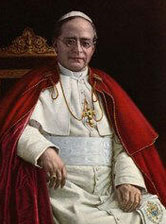 |
Pius XI
|
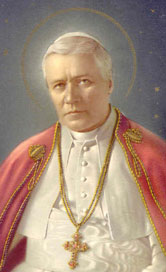 |
St. Pius X
|
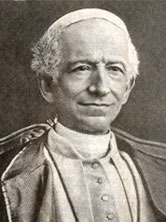 |
Leo XIII
|
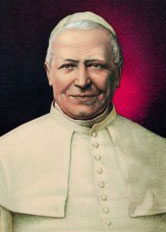 |
Blessed
|
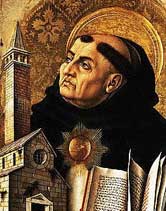 |
St. Thomas Aquinas |